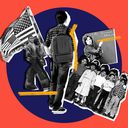Inequities in public schools fail to level the field for children of color

Published Date: 11/14/2020
Source: axios.com
In America, it's better to be born wealthy — which often means white — than to be born smart.Why it matters: For decades, the U.S. has held up schooling as the key to unlocking the American dream, but the facts tell us that education's promise is a false one.The big picture: Family income is perhaps the strongest determinant of student success, and low income becomes an even higher barrier when it intersects with race.Even when Black students from poor families start kindergarten with above-median test scores, 63% test below the median by the time they're in the eighth grade, a recent Georgetown University study found. Among Latino kindergartners in the same high-achieving, but lower-income category, 36% did worse by eighth grade; as did 39% of white students and 18% of Asian students.High-achieving students of color are too often overlooked by teachers and administrators: The odds of Black and Latino children being referred to gifted programs are 66% and 47% lower than white students, respectively, per the Fordham Institute.“If the silver bullet means education will give me the agency and resources to succeed, that it will give me power that is equal to a white man’s, that is a lie, ” says Terrence Fitzgerald, a professor of education at the University of Southern California. “That will not happen. It hasn’t happened for me.”What's happening: Decades of redlining and exclusionary zoning practices have segregated our neighborhoods and, by extension, our public schools. The zip code in which you grow up determines what school you attend. And of the 10 million kids living in America's toughest places to grow up — based on poverty rate, access to nutritious food, school quality and more — 4.5 million are Latino and 3.6 million are Black. There's a $23 billion funding gap between districts serving mostly white students and districts serving mostly students of color. Students of color — particularly Black students — are disproportionately punished at school, and punished more harshly, from a very young age. Black students are overrepresented among students suspended from public schools by 22%, per a Government Accountability Office report. Native American students are overrepresented by 1%. White students, Latino students and Asian students are underrepresented by 17%, 3% and 3%, respectively.These high levels of in-school punishment can rapidly fray students' trust and engagement in school — and saddle them with delinquency records, fueling the school-to-prison pipeline.What to watch: The coronavirus pandemic has supercharged education's inequities, including access either to broadband or to devices to connect to remote online classes. Inequities in public school funding play an outsized role in perpetuating inequality in U.S. education and linger for years to come. Funding touches every aspect of school — from who teaches students to the availability of after-school programs to the quality of lunch. Curriculum: Recent research of lesson plans and learning materials on slavery, the civil rights movement, indigenous peoples and immigration has been seen as inadequate by experts who say these lesson plans are too sanitized, if these topics even get taught at all.There's an unequal reliance on school-provided resources, such as counseling, health insurance and lunches, and discrepancies in who gets what. Police and security are present in schools that serve mostly Black and brown students in a way that white students don’t contend with.The bottom line: “The idea that this is about who’s smart and who’s not is just not true,” says Anthony Carnevale, founder and director of Georgetown’s Center on Education and the Workforce. “In the end, the system pretty much places you where you were as a child. Education is the problem. It is not the solution.”